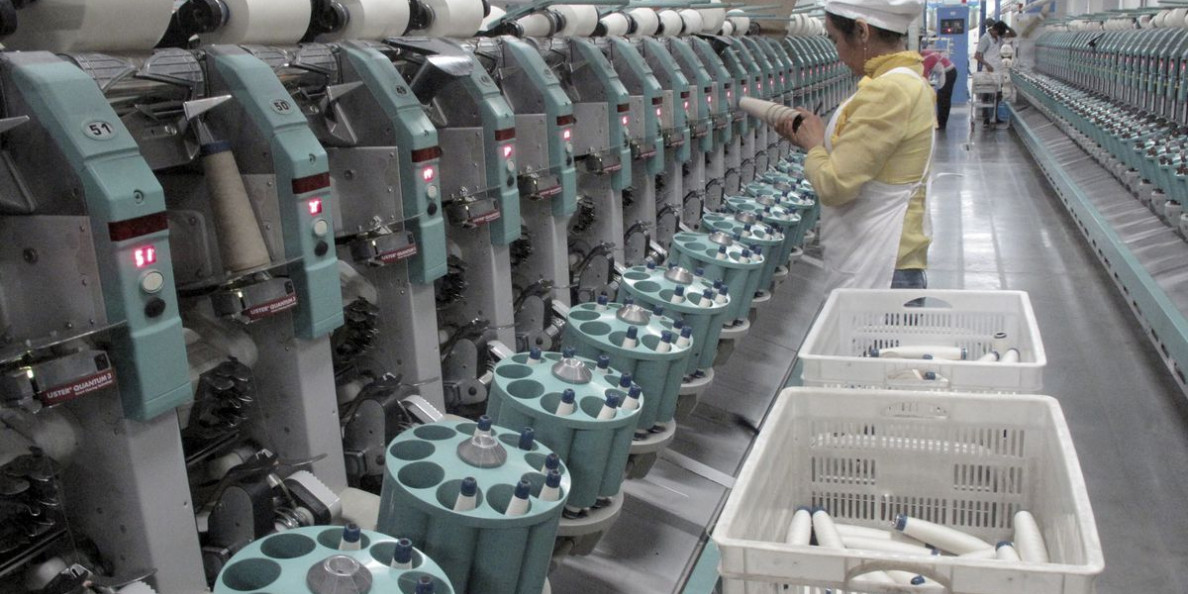China domestic market performance
In July, domestic textile and apparel retail sales fell month-on-month and rose year-on-year.
In July 2021, the total retail sales of social consumer goods nationwide were 3492.51 billion Yuan, down 7.1% month-on-month, up 8.5% year-on-year. In January and July, the total retail sales of social consumer goods were 24682.94 billion Yuan, up 20.7% year-on-year.
In July 2021, the retail sales of garments, footwear, hats and knitwear scored at 94.5 billion Yuan, up 7.5% year on year. During Jan to Jul 2021, the retail sales of garments, footwear, hats and knitwear scored at 767.3 billion Yuan, up 29.8% year on year.
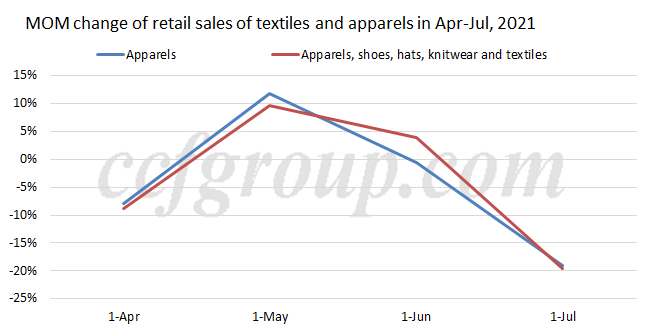
During Jan to Jul, the online retail sales of goods scored at 7110.8 billion Yuan, up 21.9% year on year, with growth rate down by 1.3 percentage points compared with Jan-Jun, with that of physical goods scored at 5813 billion Yuan, up 17.6% year on year, with the growth rate down by 1.1 percentage points compared with Jan-Jun. Among the physical goods, retail sales of clothing rose by 21.6% year-on-year (the growth rate down by 2.5 percentage points compared with that in Jan-Jun), with that of food and goods increased by 23.7% and 15.8% respectively (the growth rate rose by 0.2 percentage points and declined by 0.9 percentage points respectively compared with Jan-Jun).
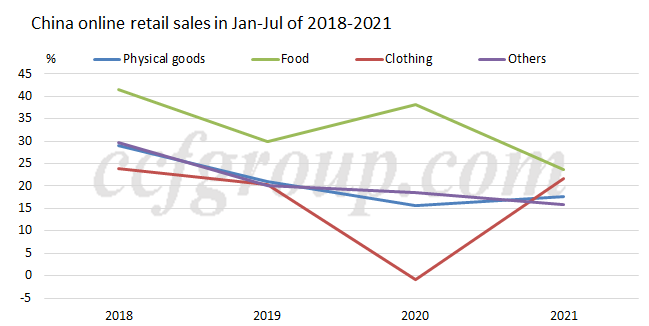
Exports of textiles and apparels kept falling for 3 months. The export data of apparels were better than that of textiles.
Exports of textiles and apparels continued falling in Jul but the decrement was smaller than that in May. Exports of apparels kept rising well. The cumulative export of textiles and apparels was robust in Jan-Jul, achieving growth compared with the same period of 2019 and 2020.
In Jan-Jul, exports of textiles and apparels were US$168.351 billion, up 7.73% on the year and 10.95% from the same period in 2019 respectively. Among this, exports of textiles were at US$80.252 billion, down by 10.80% on the year and up by 15.67% from 2019 level. Exports of apparels approached US$88.098 billion, up 32.89% on the year and 6.97% from 2019 level respectively.
In July, exports of textiles and apparels were US$28.273 billion, down 9.65% on the year, up 2.2% on the month and up 2.76% from the same period in 2019. Among this, exports of textiles were at US$11.698 billion, down by 26.78% year on year and 6.53% month on month respectively and up 8.65% from 2019 level. Exports of apparels approached US$16.575 billion, up 8.21% on the year and 9.42% on the month respectively and down by 1.03% from 2019 level.
The YOY growth of home textiles exports gradually narrowed month by month. In Jan-Jul, 2021, exports of home textiles approached US$18.44 billion, up 44.8% year on year, with growth rate down by 10 percentage points on the month, still up by 19.8% from 2019 level. Exports of home textiles accounted for 11% of the total textiles and apparels exports, and its export growth rate was 37% higher than that of textiles and apparels, which effectively stimulated the recovery of exports.
Exports of products such as beds, curtains, towels, carpets and blankets maintained rapid growth, with an increase of more than 40%, while exports of kitchen supplies and table textiles increased by 25% and 40%.
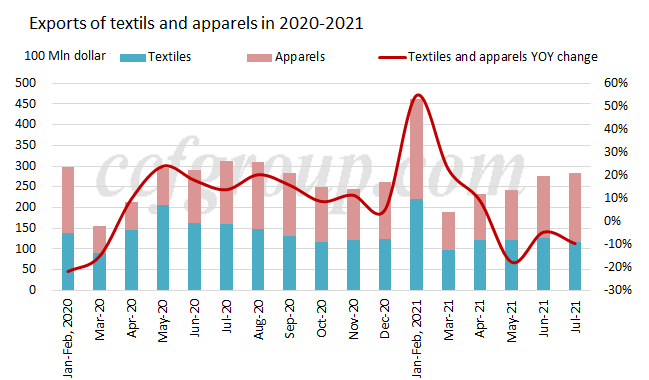
After excluding pandemic prevention materials (mask and protective clothes), exports of textiles, excluding mask, amounted to US$72.391 billion in Jan-Jul, 2021, up 43% on the year and 9% from 2019 level respectively, with export in Jul up by 17% on the year and 4% from 2019 level respectively. In Jan-Jul, 2021, exports of apparels, excluding protective clothes, totaled US$86.686 billion, up 46% on the year and 6% from the same period of 2019 respectively, with exports in Jul up by 22% year on year and down 1% from 2019 level.
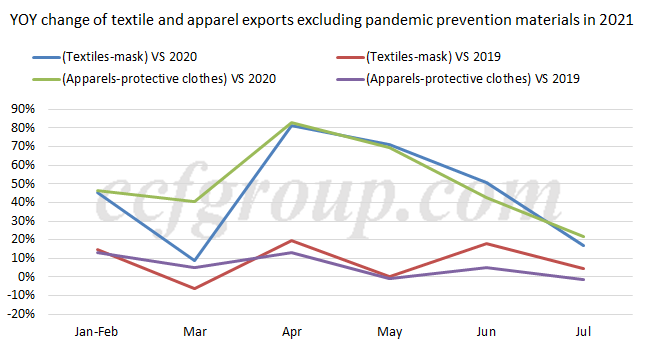
According to statistics from the General Administration of Customs, China's exports to the United States, the European Union, Japan and ASEAN all experienced slower growth or accelerated declines. Among them, cumulative exports to the United States and ASEAN continued to grow.
In July, exports to the United States fell by 17.5%, which was only 2 percentage points larger than that in June. Cumulative exports to the United States have continued to grow. From January to July, exports to the United States were US$30.78 billion, a year-on-year increase of 5.9% and an increase of 16.5% over the same period in 2019. Among them, knitted garments increased by 43.4%, a decrease of 3.7% over the same period in 2019.
The growth rate of exports to ASEAN countries in July slowed down to 2.7% year-on-year due to high-base effect. From January to July, China's textile and apparel exports to ASEAN countries increased by 30% year-on-year, the fastest growth among the four major markets and an increase of 22.7% over the same period in 2019. In perspective of product groups, yarns and fabrics increased by 34.4% year-on-year and 6.6% from 2019. Due to the impact of the new waves of intensified epidemics, ASEAN countries such as Vietnam, Cambodia, and Myanmar have shut down some textile and garment mills, so a large number of orders have been shifted to China.
In July, China's exports of garments to the EU fell 1.8%, the first decline since February. From January to July, China’s textile and apparel exports to the EU were US$26.16 billion, a year-on-year decrease of 20.4% and an increase of 11.4% over the same period in 2019. Among them, the export of woven garments increased by 17.4%, an increase of 0.7% over 2019.
The downward trend in exports to Japan continued. From January to July, China's textile and apparel exports to Japan fell by 8.9% year-on-year, and increased by 3.4% year-on-year. Among them, the knitted garment exports increased by 7.5% year-on-year and a decrease of 7.3% from 2019.
Performance of market outside China
U.S. retail market weakened month-on-month
U.S. retail sales fell 1.1% month-on-month in July, the second month-on-month decline in the past three months, far exceeding market expectations, according to data released by the Commerce Department. Retail sales in July still rose by 16% year-on-year and were above pre-epidemic levels, but the growth has slowed significantly.
In July, retail sales at apparels stores were $25.8 billion in US, down 2.6% month-on-month and up 43.4% from the same period last year. The growth rate slowed, but it was still up 15.3% from the same period before the epidemic, maintaining strong market sales.
EU market recovered
Since June, the EU has restarted the flow of people and encouraged people from all countries to travel within the EU, further promoting tourism-related catering and retail industries. The recovery in retail sales is a sign of a V-shaped recovery in the EU economy. Retail sales of goods in the EU rose 5.3% year-on-year and 1.2% month-on-month respectively in June, according to Eurostat. Textiles, clothing, footwear and automotive fuels performed best. In May, retail sales of textile, apparel and footwear rose 31.7% year-on-year and 48.3% month-on-month respectively, which is expected to continue to pick up in the coming months. Online shopping has weakened as physical retail recovered, with retail sales up 17.1% year-on-year and down 2.6% month-on-month.
The Japanese market was recovering, but slowly
Japan’s Ministry of Finance recently released the statistics for June, with retail sales of apparels reaching 718.8 billion yen, down 12% year-on-year and up 15.4% month-on-month, rising sharply month-on-month for two consecutive months. Compared with the same period in 2019, it still declined by 23%, which was still a considerable gap from the pre-epidemic level. Although Japan as a whole showed a recovery trend, Tokyo and Osaka saw slow recovery amid emergency.
The import proportion of textile and apparel from China largely decreased in EU, US and Japan.
According to Eurostat statistics, from January to May, the 27 EU countries imported US$52.93 billion of textiles and clothing from the world, down 1% year on year. Among them, imports from China fell by 27.6%, with China accounting for 32.2%, down from the same period in 2020, but still higher than the same period in 2019. Among them, textiles accounted for 42.3% and clothing accounted for 27.9%, both lower than in 2020, but higher than the same period in 2019. ASEAN's market position was further improved, with EU imports of textiles and clothing from ASEAN increasing by 37.8%, accounting for 13.3%, higher than the previous two years.
According to statistics from the U.S. Department of Commerce, from January to June, U.S. imports from the world reached US$65.11 billion, up 21.8%, while imports from China fell 1.2%, with China accounting for 30.3%, higher than the same period in 2020 and lower than the same period in 2019. Among them, textiles accounted for 36.6%, lower than the same period in 2019 and 2020, and clothing accounted for 27.9%, higher than the same period in 2020 and lower than the same period in 2019. Imports of textiles and clothing from ASEAN increased by 36.7%, accounting for 25.7%, higher than the previous two years.
According to statistics from Japan’s Ministry of Finance, from January to June, Japan’s imports from the world fell 5.9%, and imports from China fell 13.3% , with China accounting for 54.9% , lower than the same period in 2020, but higher than the same period in 2019. Among them, textiles accounted for 57.5%, lower than the same period in 2020 and higher than the same period in 2019. Clothing took up 53.9%, lower than the same period of 2019 and 2020. Imports of textiles and clothing from ASEAN increased by 4.1%, accounting for 29.6%, higher than the previous two years.
Downstream market still failed to see improving new orders, hard to move up. Stocks of grey fabric plants and traders remained high. Inventory of grey fabric started falling from Aug in 2017-2019 and began to reduce from mid-Jul in 2020 when sales were unsmooth in the first half of 2020 due to the pandemic. Stocks of grey fabric kept mounting year to date and have been above the high level in 2017-2019, flatting with the high level in 2020.
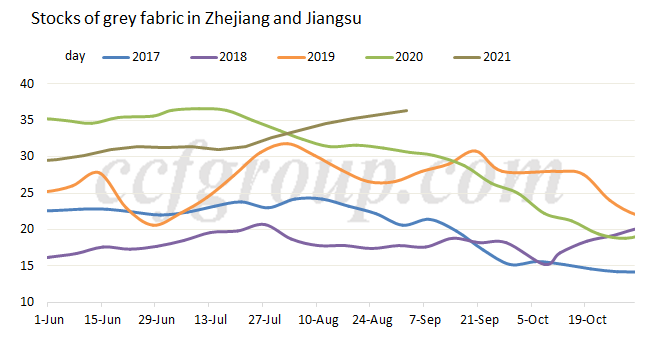
Reflected by fabric mills, export orders have been pulled forward, with export orders for autumn and winter wear almost ended. Players focus on delivering now, but tight container and high sea freight still affect the normal sales speed. As for domestic sales, autumn and winter products have been filled the warehouse of some traders and many will not replenish before actual consumption improved. In past years, downstream buyers would replenish before holiday in Aug-Oct, while this portion of replenishment has been pulled forward in the first half of this year. The consumption before the Mid-autumn Festival (Sep 19-21), National Day holiday (Oct 1-7) and the online shopping spree on Nov 11 and Dec 12 should be noted. After stocks at warehouse being digested, whether downstream buyers will restock should be concerned.
Πηγή: ccfgroup.com
